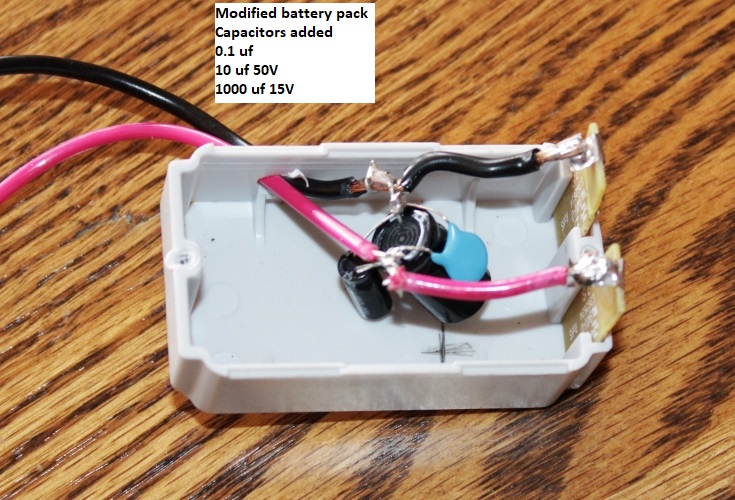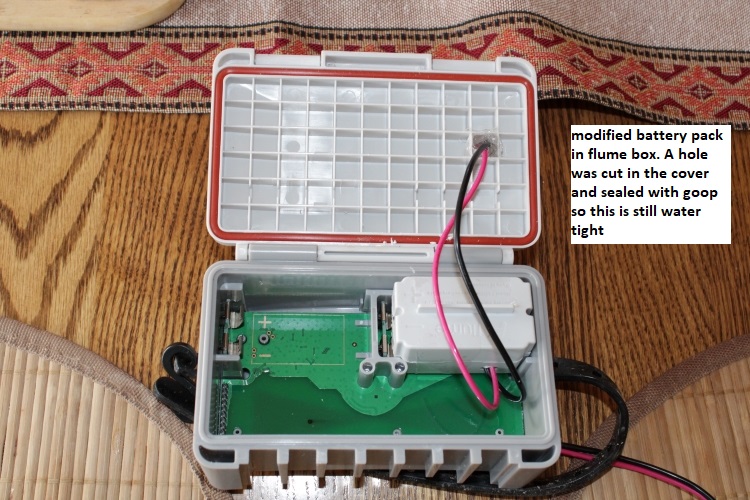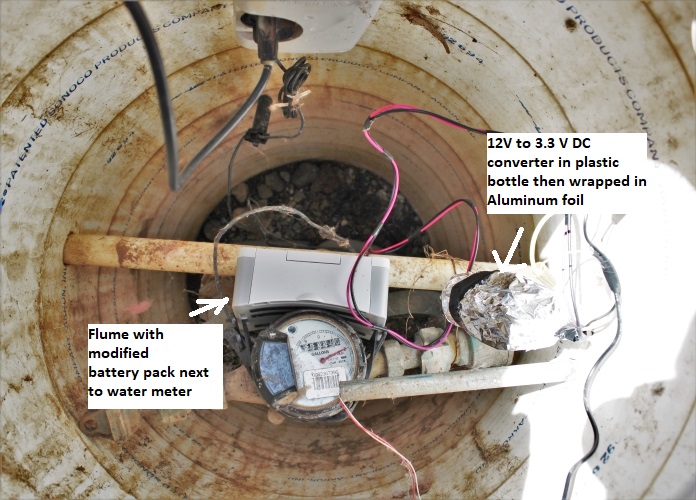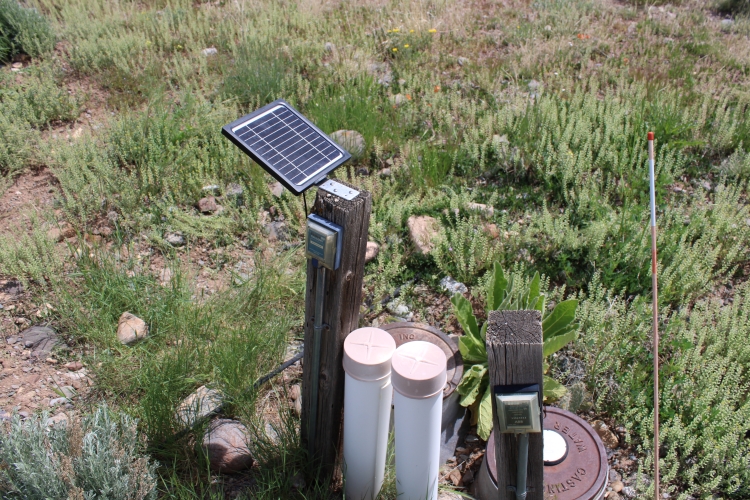
Experiment to convert Flume water meter / cell phone app to solar power.

Warning.. this conversion drills a hole in the Flume pit module plastic waterproof chassis. This will invalidate the warranty
This page describes an experiment to use an off the shelf solar game camera charged battery to power the Flume pit module https://flumewater.com/
The Flume system is easy to set up with a useful cell phone app.. A Wi-Fi/ internet link is required but there are no monthly subscription fees. The cell phone app allows monitoring of the water flow and accumulated usage from anywhere you get cell service. The module at the water meter pit that picks up the water meter reading is powered by an internal battery. Inside the Flume pit module are slots for two batteries and in my case, a single battery lasted on the order of six months. When the battery is exhausted, the module at the meter pit has to be removed and the battery replaced, the reinstalled and calibrated.
There is an analysis at the end of this page but a very small solar panel is adequate for supplying all the power the Flume pit module requires. In this experiment, a solar charged game camera module was used along with a separate DC to DC converter to replace the Flume pit module battery. The off the shelf solar module used here has a 5W panel charging a 5200 mah Li-ion battery (at 3.7V) with a 12V cable output. The solar game camera module has an internal battery with charge management and this is used instead of the battery in the Flume module. The link below shows the game cam solar charged battery used for this experiment.
The 12 volt output from the trail cam solar module has to be converted to 3.3 volts for the Flume pit module. An efficient switched DC to DC step down converter based on the LM2596 IC was used to convert 12 volts from the game camera solar module to 3.3 volts for the Flume module. The output voltage is tuned by a potentiometer on the DC to DC converter which must be done and measured before applying this voltage to Flume box. This is DC to DC converter that was used https://www.amazon.com/dp/B07PDGG84B?psc=1&ref=ppx_yo2ov_dt_b_product_details
Details
Picture below show the Flume pit module battery. I believe it is 3500mah. The unloaded voltage was measured at 3.58 volts on a new battery. I chose to set the DC to DC converter output to 3.3 Volts. I had an old used up battery and carefully opened the case and removed the expired battery. The case is going to be used for the conversion.

The battery case is re- used to supply power to the Flume pit module. I added some capacitance to make sure the AC impedance was low to best simulate a battery. Each of the capacitors goes across the DC power wires noting polarity for the Electrolytic caps. The capacitance chosen was a guess. Once the modification shown in the picture below was made, the top cover of the battery pack was put back on.

Picture below shows the modified battery pack in the Flume pit module. I drilled a hole in the case for the DC voltage wires to exit the case and filled the area with goop glue to keep the box water tight. Warning, drilling the hole voids the warranty of the Flume system.

Picture below shows the game cam solar battery with the 12 volt output cable soldered to the DC to DC converter. The DC to DC output voltage is adjusted to 3.3 volts by a potentiometer. DC wires then go to the Flume pit box and power the Flume via the solar charged battery pack.

The DC to DC converter uses switching technology which can create emissions so the circuit was first put in the end of a plastic bottle, then tin foil wrapped around the bottle to create at least somewhat of an emission shield. The Flume system did work with this install and the module inside the house is about 300 ft. from the pit where the meter and Flume pit module are located. The shielding on the DC to DC converter may not be needed but I did not test this. If the pit is prone to flooding, making this DC to DC converter waterproof would be something to consider.

5W solar panel and battery module mounted outside the meter pit. The panel has tilt to the South partly for winter sun angles and so that snow slides off. Part of the reason I picked this panel was that it had a temperature spec of

Some numbers to show this "should" work fine for a long time.
The Flume battery is 3.5V with a capacity of 3500 mah. The only data point I have is mine and its not exact but the battery lasted about six months or 4392 hours.
Divide battery capacity by life time to get average current draw: 3500 mah/ 4382h-= average current draw over the life of the battery = .796 ma @ 3.5Volts. The DC to DC converter has some loss and there is an LED on the DC/DC module that is on when there is an input voltage. I'm guessing 2 ma consumed by the converter and .796 ma to the Flume for a total estimated load of 2.79 ma at 3.5 volts
The total estimated power load of the DC to DC converter and Flume pit module is then .0097 watts. (2.79 ma * 3.5V). In 24 hours at this power, the total watt hour used is .234 WH.
So in a 24 hour time period at the estimated average power, we have an accumulated draw of .234 Watt Hours. Assume a poor sun day in the winter where the panel output is only 3 watts and only for an hour during the entire day. The watt hours generated by solar for these poor conditions is still 3 watt hours. So the panel even on a very poor day in theory generated a factor of over 12 times more than what the DC converter and Flume used. I.e., we have way more capacity than needed which is good.
The battery in the game camera solar is actually higher capacity than the battery that is used by Flume. So even if the solar were to go out for many months, the battery should still keep things running. Many estimations were made in this analysis but the capacity margins are so large that this "should" work fine.